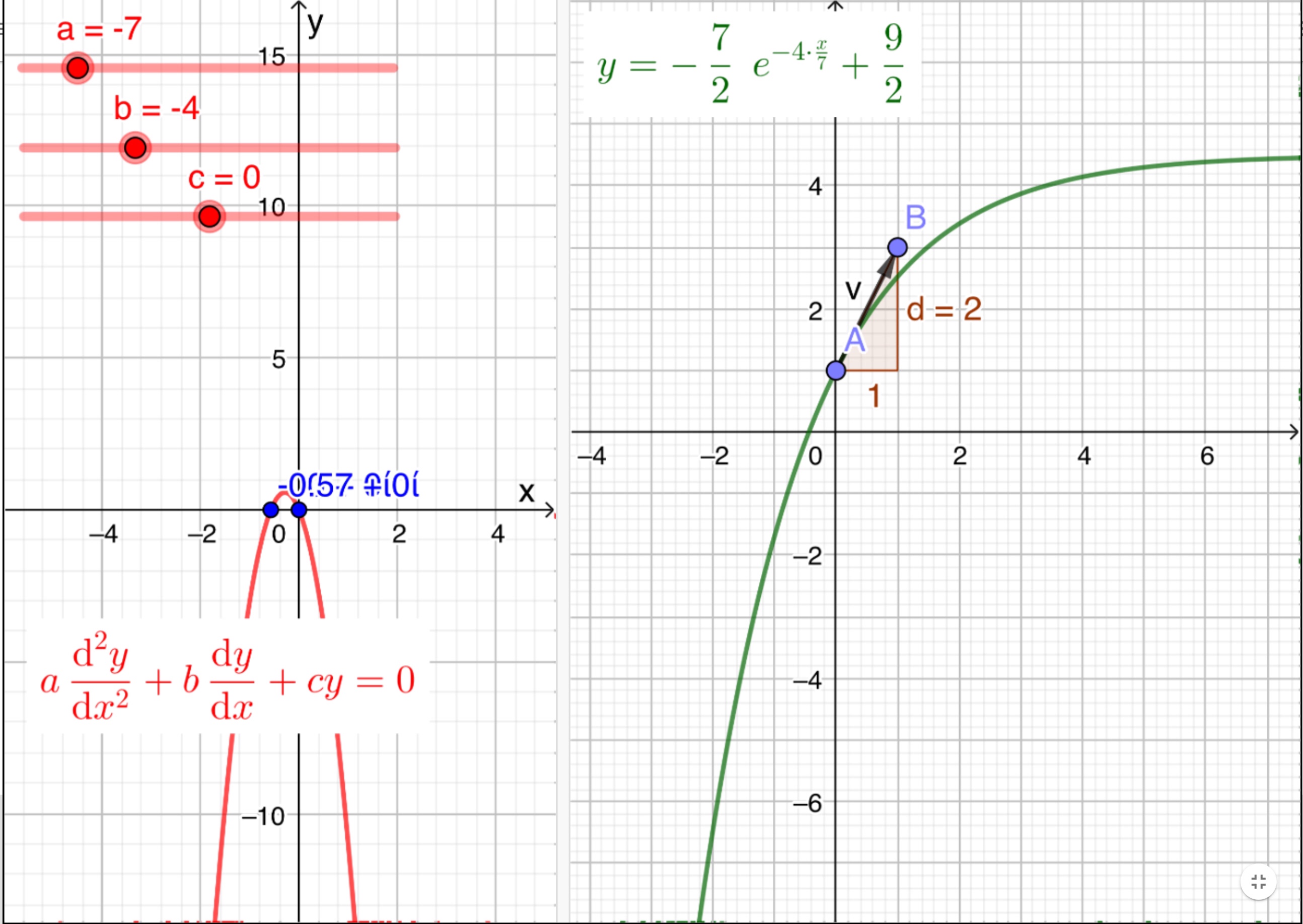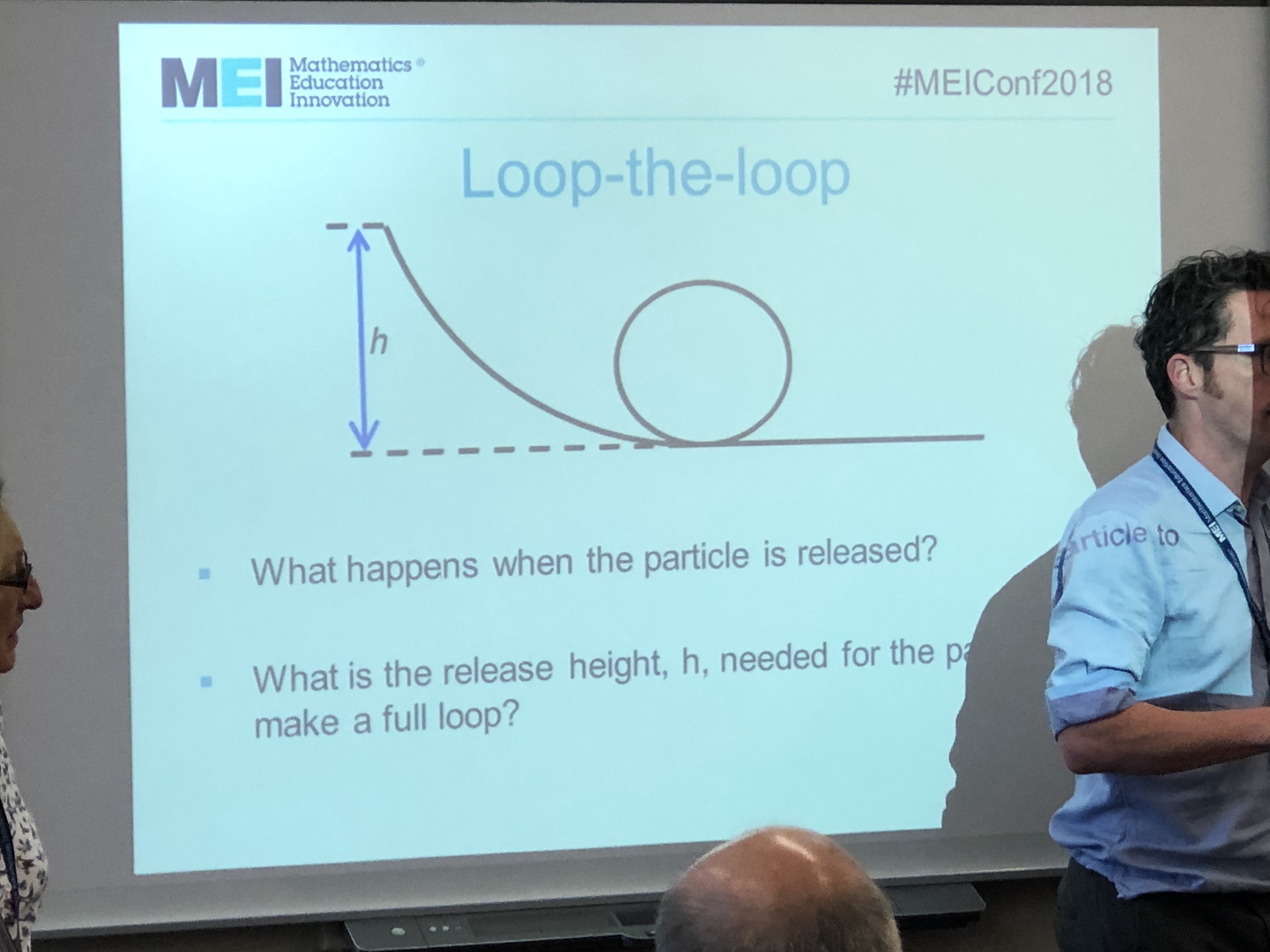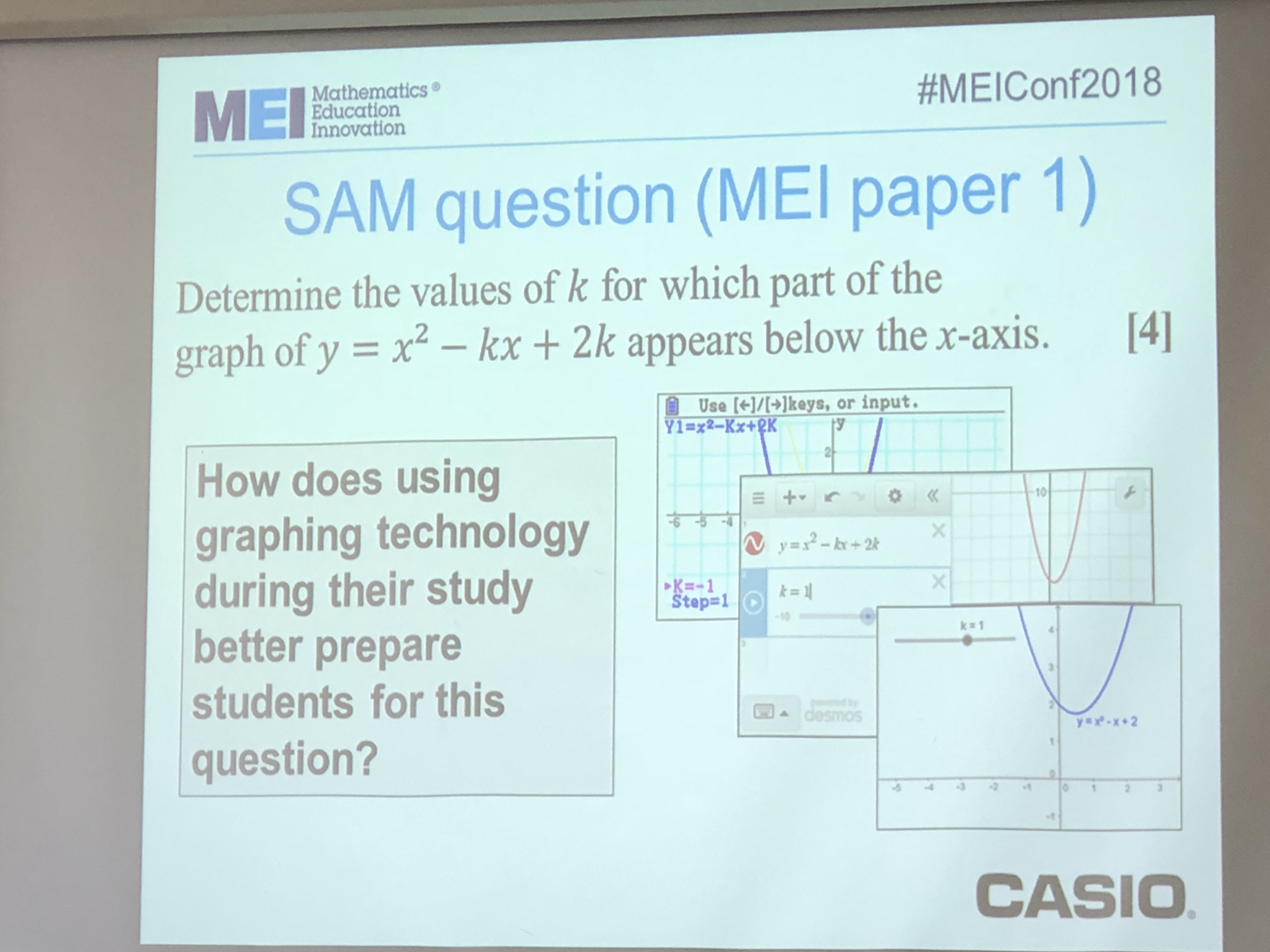It’s MEI Conference time of year again! Sadly as a Maths Hub Level 3 lead I am going to be unable to attend most sessions on Friday and I can’t make Saturday due to family commitments so I need to make the most of today!
Session A: Differential Equations in A-Level FM (Sharon Tripconey)
The maths for the day (well apart from Tom Button’s mathematical interlude during the opening plenary – give the question a go here.) started with a great session on differential equations with Sharon from MEI.
I loved the start of the session activity – a classic Venn diagram activity that really made you think.

Differential equations are in content areas G6, H7 and H8 in the new A-Level specification (only first order by separation of variables).


For further maths there is a lot more differential equations content in the compulsory
content than students would often meet before – including simple harmonic motion.

In the 2017 Further Mathematics Qualifications the concept of linked differential equations will be new unless you taught MEI Differential equations.

Sharon emphasised that what we do in A-Level maths should support the further mathematicians and so it is important that we expose all A-Level students to differential equations that can’t be solved by separating variables. I wholeheartedly agree with this.
A bit of time was spent looking at the integrating factor method – In my experience lots of practice of implicit differentiation needs to be done by students before tackling this topic as being able to spot the function which after application of the integrating factor method is less likely to result in mistakes than just remembering the IF method by wrote (in my opinion anyway!)
Sharon shared a lovely Geogebra worksheet from the MEI Geogebra Institute. In this you can explore how the solutions to a second order homogenous change as the coefficients change. It is also nice to be able to see the roots of the auxiliary equation plotted on a graph.
We began to look at some practical situations which lead to differential equations; possible examples are
- Motion against a resisting force
- Oscillations
- Damped oscillations
- Forced oscillations
After a brief into we performed a very easy practical involving a bottle of water, an elastic band and a plastic bag. I’m ashamed to say I have never thought of doing this in a classroom.
Great simple to do practical involving elastic bands, a plastic bag and a bottle of water. Can then be developed with some mathematical modelling to derive the differential equation. So far @MEIConference is certainly living up to how good the previous ones have been. pic.twitter.com/DB1VwZ4aVl
— Tom Bennison (@DrBennison) June 28, 2018
Once students have had a bit of a play they can easily be led through the modelling of the physical system, discussing how to model the resistive force would be particularly interesting.
The slide below has also reminded me of an old Geogebra file that I have which demonstrates oscillations for a variety of parameters. I’ll dig this out and share it on here sometime next week.
There was only one slide that concerned me in this session — however as she spoke through it she emphasised that she meant “analytically solvable”. Overall I like this slide as I think it is vital that time is taken to emphasise correct use of mathematical terminology in this topic.

Session B: Preparation for Oxbridge and Other Elite University Applications (Rachel Sharkey)
Rachel began the session by briefly discussing her research for her EdD which looked at how teacher’s cultural capital and connections impact their students’ applications to university.
She made an interesting comment that she has heard that the different questions on the TMUA are ranked differently, but this is not official. TMUA questions are intended to be like Olympiad questions, but multiple choice. I also wasn’t aware that Warwick University no longer requires STEP.
She shared her version of a personal network diagram which she advocates as a way to understand the capital that you bring to your students as a teacher.

This was interesting and provided the source of some debate in the session… I should perhaps go and think about this for myself more.
She talked about ways to help students demonstrate an interest in mathematics:
- Structured Reading: Provide structured reading chapters from a few books on the same topic – in her case infinity – send them away to read and then discuss as a group.
- Presentations: Students research and present a topic beyond A-Level maths. This increases student’s own capital and their peers when they listen.
- Independent Reading: Provide help with the reading lists provided from the universities. They then write a book review as this provides a short summary of the book which they can call on during interview or when they are putting together a personal statement.
When preparing students for the admissions tests Rachel has started grouping questions by the skill/technique used including the following:
- Completing the square.
- It’s ok to try numbers.
- Graph transformations.
For the longer form questions her advice is very similar to my default advice. I think one of the most important things is that students need to be very proficient with the algebra, checking every step of the working, watching out for signs and to ensure that they use previous steps of a question later on in the question.

Chris Sangwin, the admissions tutor for maths at Edinburgh University emphasised how useful it is for teachers to contact the admissions tutors in universities they often send students too. They are often happy to say things in person that can’t be written down on a University website.
Session C: Mechanics in A-Level Further Mathematics (Sue de Pomerai and Tom Button)
Sue and Tom had to deliver this session instead of Avril at short notice, but you couldn’t tell!
They started with a brief summary of where each mechanics topic sits in the new linear Further Maths A-Levels (which strangely are described with modules)

Hopefully before students study elastic potential energy they will be familiar with Hookes law that states the force is proportional to the extension. Tom then discussed using a spring balance in a very simple way to help students understand elastic potential energy.
If you pull on a spring balance what do you notice? (Maybe you notice that the scale is linear and that if you exert a greater force then the extension is longer – what do these mean? )
From Hooke’s law, considering the area under the graph of force against extension it is clear that the area under the curve is the elastic potential energy \( EPE = \frac{1}{2}kx^2 \). Tom talked about this being a fantastic situation to draw out any misconceptions using the fact that Work Done = Force * Distance – in this case we do not have a constant force.
I really liked this question that Sue shared:

This would really check the understanding of students, especially if you asked them to explain their reasoning, possibly bringing any misconceptions to the foreground.
There was a very interesting discussion about attempting to move a heavy rock. You have done some work (and expended energy) but what if the rock hasn’t moved – with the usual definition we wouldn’t have done any work, yet energy has been expended. Sue emphasised that with any mechanics work we are working with ideal situations, have made assumptions and so the model does not always represent reality. I agree that emphasising these assumptions with students is very important – what seems obvious to us (we probably know the assumptions made and the impact they have) is likely not obvious to the students beginning their mechanics journey.
Top Tip: If you want to do practicals with balls that don’t bounce take a a ping-pong ball, poke a hole in it (with a compass or a drill). Now cut up a lot of thin elastic bands into little strings and stuff your ball with them. Keep filling them with elastic until the ball doesn’t bounce.
With the increased emphasis on mathematical modelling in the new A-Level it is important that we develop mathematical models for physical situations with our students. Sue led through modelling a bungee jumper. We started by finding the spring constant (plotting weight against extension and finding the gradient – how is this related to k?) Developing the model leads to a quadratic in the extension x which can be solved.
We then looked at a loop-the-loop situation. 
Paul Glaister (of Reading University) got to have a bit of fun with this…
@p_glaister having fun with a loop the the loop track in @suedepom and @mathstechnology ‘s mechanics session at the @MEIConference pic.twitter.com/76ZU1DpsCm
— Tom Bennison (@DrBennison) June 28, 2018
All of these practicals are contained in the classic “Mechanics in Action” book. I may blog about this at some point in the future.
Session D: Student Tasks for Integrating Technology in A-Level Maths (Tom Button)
This session was about the student tasks developed by MEI that are designed to expose students to the benefit of technology in lessons.
The first thing Tom showed us is the very cool graph \( y = x^5-5x^3+5x \).

There are two cool things about this graph – I will let you explore this..
We then investigated the graph \(y = x^3 + ax+1\)
- When (what values of a) does the graph has maxima and minima?
- What affect does a have on the intersection of the graph with the x-axis?
- What is same / what is different?
- What is important about the point (0,1) in this graph?
- How does the gradient change at (0,1)?
The point (0,1) on this graph is a non-stationary point of inflexion – now in the second year of A-Level.
Tom shared a load of the MEI Student Tasks. Their are sheets for Desmos, Geogebra and graphing calculators.
As a group we discussed the task below.

The emphasis on how the technology supports the learning of this session was great – too often it can be easy to focus on the cool things tech allows you to do. I know I am guilty of this!
The structure of these sheets is also really nice.
Towards the end of the session we considered a question from the MEI SAMS Paper 1.

One interesting point made, that I hadn’t really considered before is that using technology may in itself lead to students being more comfortable with functions having more than one unknown.
Plenary (Charlie Stripp, Kevin Lord, Stella Dudzic)
The plenary today was also being live streamed as it was also serving as a launch of the Advanced Maths Support Programme. It is always nice to see positive graphs such as these:


I hadn’t seen this graph below which is at least still encouraging:

However – what will happen next year?
Kevin Lord then provided a very informative introduction to the AMSP (Advanced Mathematics Support Programme). It sounds a very supportive and exciting programme which I will be keen to be involved with. The new extra focus on the AMSP Priority areas is also welcome. These are comprised of the 12 government Opportunity areas and 20 areas that have been identified as having low Level 3 provision.

One of the key tasks for the AMSP will be to increase the percentage of institutions offering Core maths – currently only around 17% of institutions enter students for this exam.
Stella Dudzic then spent some time talking about Core Maths. I’m very excited about the Core Maths Online Teaching Platform.

Food:
Everyone knows that the most important aspect of any conference is the food and luckily the food today was as good as the sessions.





